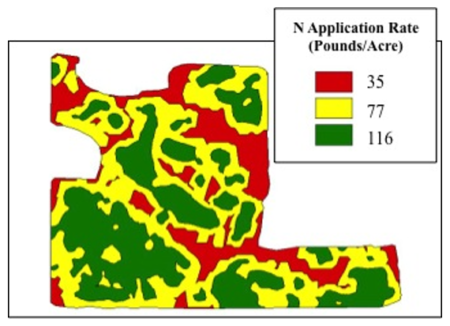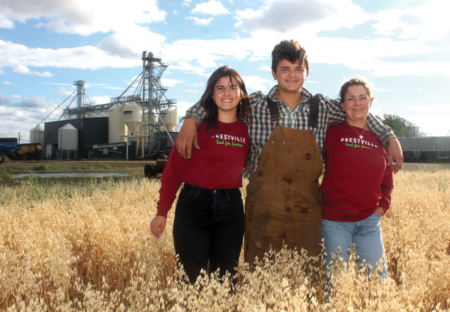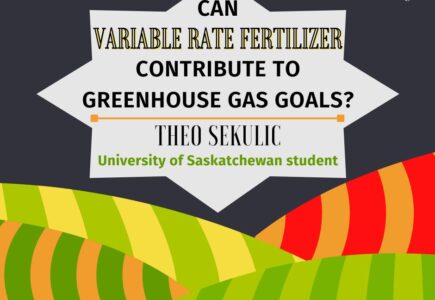By Theo Sekulic
University of Saskatchewan student
The adoption of variable rate fertilizer (VRF) application has become an area of debate for farmers across the prairies. The main topic for this debate is the efficacy and cost-effectiveness of adopting the new technology. However, is this really the most important factor regarding the adoption of VR? In 2020, the federal government announced new goals to reduce fertilizer-related emissions to 30% below 2020 levels by the year 2030. The announcement of this new goal for the proposed reduction of fertilizer related emissions has been met with intense scrutiny by producers and proponents of agricultural production in Canada. As stated in the article, it will not be a mandatory reduction in use, rather a voluntary option for growers. Rather, that they would support measures that producers can use to reduce emissions while aiming to maintain growth in crop yields. This is interpreted by most producers as a misguided and uninformed statement by the government, as historically, increased use of fertilizer has been positively correlated with higher yields in the field. Farmers and advocates of sustainability greatly understand the importance of nitrogen fertilizers for maximizing yield, and the push to reduce this capability are perceived as threats to their bottom line.
Finding Compromise with VRF
The plan to reduce nitrogen-related fertilizer emissions by the federal government has created a unique opportunity for VR technology. The adoption of VR has been slow amongst prairie farmers due to doubts of economic benefits, utilization of complex and expensive technology, and lack of continuity between different VR technology vendors. After a survey conducted in the fall of 2021, it was found that only 10.2% of growers used VRF in their fields, displaying a drop in VRF application from 11.8% in 2020. Studies and trials surrounding VRF technology have shown a reduction in nitrogen fertilizer induced N2O emissions from high yield management zones when compared to low yield management zones. This confirms that VRF can help mitigate instability in N2O emissions from cropland soils. High yield zones had the lowest emission factors despite receiving 50% more fertilizer than low yield zones. On the contrary, low yield zones in the trials had higher emissions factors despite receiving 50% less fertilizer than high yield zones, showing the environmental consequences of applying high rates to unsuitable soil conditions.

While the actual rate of fertilizer applied with VRF may be indifferent to conventional application, applying higher rates in high yield zones and lower rates in low yield zones can allow more efficient use of costly resources. This process simultaneously reduces greenhouse gas emissions related to nitrogen fertilizer by prescribing the proper rates in suitable field zones. The figure is an example of a variable rate application map created to prescribe differing rates of nitrogen fertilizer depending on the suitable field conditions. This prescription map would be loaded into an application onboard a piece of machinery, then used to communicate with the implement that is applying the fertilizer to adjust application rates on the fly.
Creating the Conditions for VRF Adoption
While VRF provides marginal benefits, do they exceed marginal costs? The roughly 20-years to date of VR technology application does not boast its credibility. Technology like VRF is a dime a dozen in the agriculture industry and adoption issues are compounded by the importance and imperativeness of fertilizer application. While strapped for time in the busy seeding season, it can be seen as another piece of technology that either will not function properly or hold up production. These issues of mistrust are also fueled by the deviations of price, soil zone sampling, and application from different VRF service providers. Farmers rely on constant information being provided to them by others, including other producers, agronomists, and crop input retailers. This variability between vendors leads to mistrust as there is constant comparison in the proper application of the technology, the standardization of VRF practices could help to mend these trust issues. One could assume that this is an effort from the government to incentivise the adoption of VRF through means of tax credits and potentially carbon credits once the GHG reductions can be adequately measured. This of course follows the assumption that the federal government has intentions to follow their emissions control narrative while also supporting farmers. VRF should be something that farmers want to pursue due to its economic and ecological benefits, overcoming the issues surrounding adoption are necessary to its success.
Biography
 I am a student at the University of Saskatchewan pursuing a Bachelor of Commerce in Finance. Growing up on a family farm in Rycroft Alberta, agriculture has always been a passion of mine. The need for constant innovation and change is necessary in our area due to the severity of the northern climate and the shortness of our growing season. I plan on continuing the family tradition of farming after I graduate school, between our pedigree seed business, expanding land base, and growing herd of cattle there will be no shortage of opportunity.
I am a student at the University of Saskatchewan pursuing a Bachelor of Commerce in Finance. Growing up on a family farm in Rycroft Alberta, agriculture has always been a passion of mine. The need for constant innovation and change is necessary in our area due to the severity of the northern climate and the shortness of our growing season. I plan on continuing the family tradition of farming after I graduate school, between our pedigree seed business, expanding land base, and growing herd of cattle there will be no shortage of opportunity.

